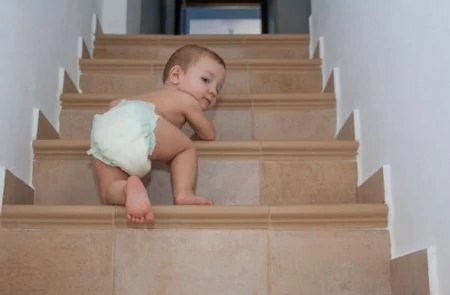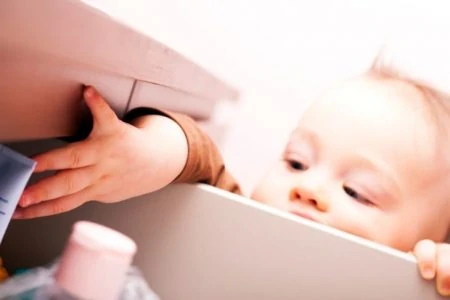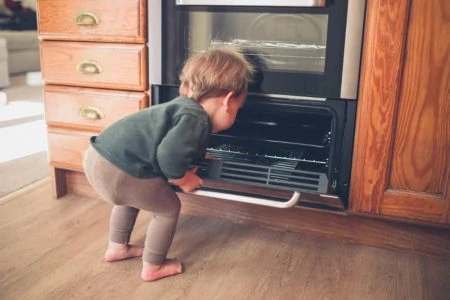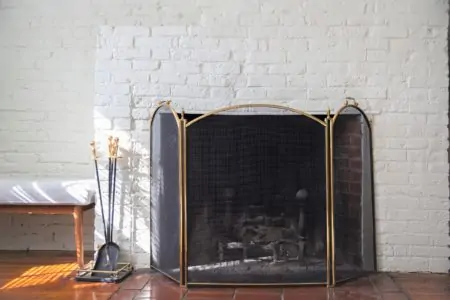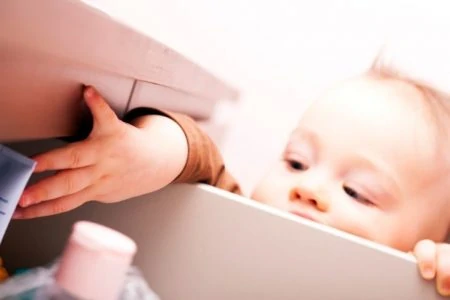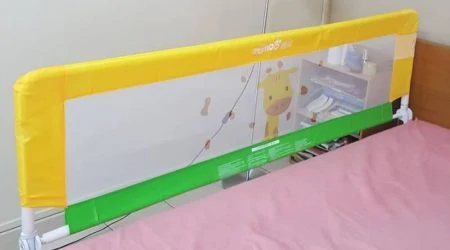Have you ever had a scary moment watching your little one teeter toward a staircase?
If you haven’t already started babyproofing your home, the stairs are a great place to begin. In the United States, a child is injured on the stairs every 6 minutes (1).
We’ll help you take the safety measures necessary to avoid a stair-related injury. We’ll talk about when and how to start babyproofing your stairs and explain how to install a baby gate.
With a little care and know-how, you can ensure your home is safe for your little one while still being accessible to you.
Key Takeaways
- Babyproof stairs when your child is around 6 months old, before they start crawling or walking.
- Install baby gates at both the top and bottom of stairs to prevent access.
- Choose the right baby gate for your home, considering factors like frequency of use, space, and style.
- Regularly inspect stairs for maintenance issues and remove potential hazards like clutter.
When to Start Babyproofing Stairs?
In clinical practice, I begin the discussion of “babyproofing” the home at the 6-month-old well visit. I feel that this is a good time to have the discussion because most babies have not yet become self-mobile.In general, infants begin crawling between 6 and 12 months of age. Some can pull themselves to a standing position or take steps while holding onto furniture around the same time. Having an early discussion gives the parent time to prepare and find the best stair protection option.
Editor's Note:
Dr. Leah Alexander, MD, FAAPWhich Stairs Should Be Babyproofed?
Any stairs in your home will need to be babyproofed, no matter how big or small. Steeper staircases will need extra attention, but you should limit your baby’s access to any sets of steps in the house.
In some cases, there may be a single step in your home leading from one room to the other.
The best way we’ve found to handle this is to place an expandable baby gate across the step to be safe. It’s a better option than having your toddler trip, slip, or fall because of the little step.
How to Babyproof Your Stairs
When it comes to babyproofing stairwells, there’s one solid fact: there’s no way to let your child have access safely. You want to ensure you section off both the top and bottom of the stairs from your children.
Since babies are well-trained escape artists, ensuring they have no access to stairs will take the pressure from your shoulders while preventing any dangerous and daring escapes.
1. Get Baby Gates
The most obvious and reliable way to keep your baby away from the stairs is to put up a secure baby gate and ensure you install it properly. There are plenty of gates to choose from to fit your home, but whichever you pick, make sure it completely blocks access to the stairs.
2. Anchor the Baby Gates
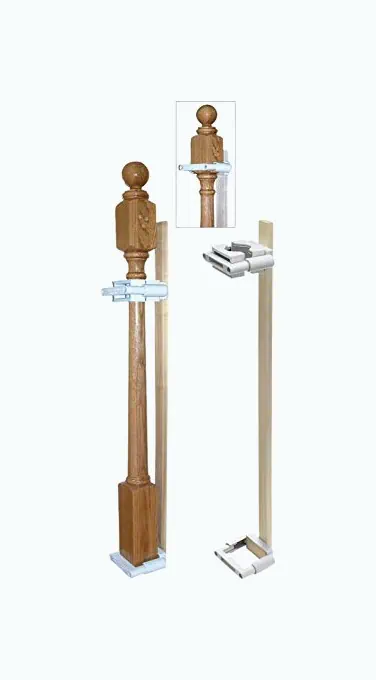
Always make sure you’ve read instructions thoroughly any time you set up a baby gate. An unstable baby gate can lead to more risk and the chance for your baby to fall. Avoid using accordion baby gates, as they can trap a child’s head or strangle them (2). And check to make sure your gates have not been recalled.
The top of the stairs, in particular, will require special attention to mount the baby gate. You may have to drill into the banister and wall to get a secure mount. If this isn’t a good option for you, you could use a mounting kit that protects your banisters from drilling.
3. Check Your Stairs
Sometimes stairs need maintenance — catching a flaw in them can be what prevents your child from getting hurt if they manage to get past a baby gate.
You should frequently inspect your home for rough edges, nails, or loose steps, especially if you have to carry your child up and down the stairs. Imagine stepping on a nail and falling with your baby!
About a quarter of children’s stair-related injuries happened while being carried by a parent.
Choosing a Baby Gate
Knowing your house and identifying its babyproofing needs will be crucial in picking out the best baby gate for you. Carefully consider how you use your stairs and what’s important to you in a baby gate so you know what to look for and don’t waste time or money.
Take a look around your home. Think about what it will be like when you set up your babyproofing tools.
Some of the following considerations may help you decide:
- Frequency of use: Ask yourself how often your stairs are in use. High-traffic areas will need something like a swinging gate or a walk-through gate.
- Space requirements: You can get gates that cover large entryways or ones that simply sit in the doorway. If you’re trying to cut down on how many gates you need to buy, consider a few large ones to section off entire rooms at a time.
- Consider the carrying: Take a look at how your house is organized. Is your laundry room far from your bedrooms? Will you need to carry your baby up and down the stairs multiple times a day? You may need a safer baby gate for high-traffic stairs.
- Style and design: While safety always comes first, you can still try to find a baby gate that better matches your idea of what your house should look like. Choosing between wood, metal, or other colors can help the gate blend in better.
- Keep objects that can be used as a stepping stool away from stairs. Toddlers, in particular, can use such objects to climb over stair gates (or onto other undesired objects). Also, make sure the height of the gate is appropriate for your infant or toddler.
3 Great Stair-Proofing Baby Gates
Baby gates come in many shapes, sizes, uses, colors, and materials. Matching the best gate for your home with your stairs prevents accidents more than anything else, but choosing the right one can seem daunting.
Lucky for you, we dug into the three best kinds of baby gates for babyproofing your stairs.
1. Expandable Baby Gates

Expandable baby gates are small, narrow gates that open slightly to fit right inside a doorframe. Not every house will have stairs with a specific door frame at the top, but if yours does, this gate style will restrict stair access.
These are ideal for the foot of the stairs since they are pressure-mounted in place. If your baby pushes against a pressure-mounted gate at the top of the stairs, it could slip and cause your baby to tumble down the stairs.
Some expandable baby gates include the necessary hardware and instructions for mounting at the top of the stairs.
2. Multi-Panel Baby Gates

Multi-panel baby gates are a lifesaver for parents. They take a little extra time and money to install, but if you can handle that, their versatility is well worth it. (I wouldn’t have made it this far without mine!)
Multi-panel baby gates can be condensed into a fence or play area or extended to cover large areas with unlimited extensions. These are perfect for homes with very wide stairwells or ones with lots of things around stairs to protect.
3. Tall Walk-Through Gates
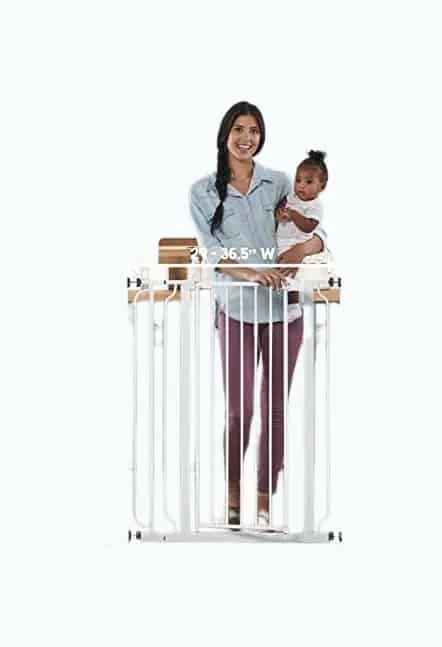
Expandable gates are great, but they come with risks too. A swinging gate can be a great solution. Combine both gate styles with the swinging gate at the top of the stairs to create an improved flow through your house, especially if you have a lot of traffic on your steps.
These gates are taller and stronger and require hardware to mount them safely. Instead of having to be risky and step over a low gate and balance on the stairs, these gates simply unlatch and swing open. The safety and convenience factors they add really help over time.
Whatever gate option you choose, the most important thing is to ensure it is correctly installed. Despite the best intentions to keep infants safe, gate-related injuries can result in emergency room visits.
How To Babyproof Stair Railings
Even if your baby is too big to slip through the banister railing, their head or limbs could get stuck between the slats, and injuries can happen. This is a very frequently overlooked part of babyproofing.
1. Get a Banister Guard

You can get a banister guard that goes along the length of your banister. They come in several different styles and materials to fit your home. They’re not exactly fashionable, but being safe is always better than being sorry.
This style of gate is usually easy to put up, but you should make sure you test it before giving your little one access to your stairs by pressing on the guard.
2. Try a DIY Solution
If you have the tools, time, and resources, making a custom railing guard can be really fun and a stylish way to stay true to your home’s decor. There are a few different methods for doing this, so search around to find the best one for your skills and budget.
3. Reevaluate Your Railings
Believe it or not, I grew up in a home without a banister along the steep steps to the basement. I have this vivid memory of following my mom, slipping with her through the gate, and promptly starting to tumble right over the edge of the stairs.
In my case, disaster was narrowly avoided when my dad noticed and caught me. After that incident, my parents installed railings on the stairs, and we never had another problem.
Sometimes replacing your banister, or installing one if it’s missing, can be the best way to babyproof your stairs. You can easily do this yourself as a low-cost project.
Tips for Safe Stairs
There’s always more you can do to increase your home’s safety. How far you take your babyproofing depends on your family culture and the time and resources you’re willing to dedicate to the task. You have to modify to your own comfort level.
Through my excessive babyproofing phase, I came across these helpful tips that improve stair safety in your home.
These are best for a little later on when your child starts using the stairs for themselves.
1. Declutter
Declutter, declutter, declutter! I can’t stress this tip enough. Stairs tend to accumulate toys, books, and clothing.
It’s pretty obvious why these are dangerous things to have on the stairs, especially if you have a toddler who is just getting the hang of climbing. A misstep onto a shirt or a slip because of a book can undo all your careful babyproofing.
2. Carpet the Stairs
As a general rule, carpeting is better for your kids than hardwood flooring. Not only does it cushion falls, prevent slips, and offer a better grip for small feet, but it’s a great way to protect the stairs themselves.
Choosing to carpet your stairs might not fit into your plans easily, but consider it the next time you’re making home improvements. It can benefit you if you’re constantly carrying your baby up and down them. When you’re tired, it’s easier to fall or make a wrong step.
3. Remove Baby Gates
You read that right: remove your baby gates when your little one reaches a certain age.
When your baby starts learning to climb, baby gates become a hazard. Despite having vertical bars to deter climbing and secure mounts, you need to get rid of them once your child is about 2 years of age.
For families with more than one child, this could become a problem. Large area gates like multi-panel gates can become handy at this point to leave the stairs open but restrict certain youngsters.
You can also start teaching your older toddlers early how to climb stairs safely.
Stair Babyproofing Don’ts
The good news is there really isn’t much you can do to mess up babyproofing your stairs as long as you follow your manufacturer’s instructions on your baby gates. By testing all of your babyproofing decisions for any weak spots, you’ll notice risks on your own.
Still, there is always a chance for oversight. For additional safety tips for stairs and other household items, this is what Nemour’s Children’s Hospital suggests.
If you’re still concerned, here’s a quick list of things you should avoid when babyproofing your stairs:
1. Don’t Wait
Waiting for the last minute to install your baby gate causes stress and leaves too much room for error. You should babyproof before the first sign of mobility appears in your little one.
Getting used to the gates before they’re needed is a smart idea, too. This is especially true if you have ones that latch to allow you to walk through. You don’t want to forget to shut it behind you or start tripping over them at night.
2. Don’t Put the Gate off the Ground
Kids are really crafty, and they’re surprisingly able to fit through tiny spaces. It’s a common problem to need a taller gate, but one of the worst mistakes you can make when babyproofing is putting your baby gate a few inches off the ground instead.
You may be gaining height, but you’re adding instability and the opportunity for your little one to slip under and tumble down.
Make sure the baby gate you buy is tall enough to restrict your child. If your baby grows too fast and the baby gate becomes a hazard, either get a new taller one or think of a new way to restrict access.
3. Don’t Put Two Gates Together
We get it. Few things are more frustrating than when you attempt to put up your baby gate and realize your doorway is too wide. It can be tempting to just put two gates together to extend the width — or even stack them for height.
But this solution is really dangerous. When you fasten gates together, they lose their stability and create a hazard for curious babies. Any time you deviate from the manufacturer’s directions, you create more risks for your baby.
4. Don’t Try to Rig a Gate
I’ve seen some crazy baby gate contraptions, and I can firmly say none of them have been safe. If you’re using a baby gate, don’t modify it in any way that isn’t approved by the manufacturer.
This includes raising it above the ground and shoving towels underneath or putting wooden blocks on the sides of the gate to make it fit into a doorway.
An excellent way to avoid this frustration and temptation is to carefully and accurately measure your doorway before choosing a baby gate, and check the measurements of the gates you plan to buy. Don’t even bother getting one that doesn’t fit your numbers.
Babyproofing Stairs FAQs
Are Your Stairs Prepared?
By making your stairs one of the entirely off-limits places for children under the age of 2, you can help prevent tons of injuries.
By choosing the right baby gate and following directions instead of modifying them, you can ensure your little one’s safety and your own security.
